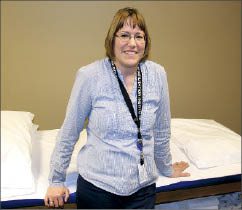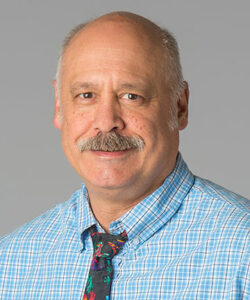
Home » After illness, therapist spearheads breast-surgery rehab
After illness, therapist spearheads breast-surgery rehab
Physical-therapy team at St. Luke's adds post-operative specialty

March 25, 2010
Valerie Wang has been a physical therapist for 36 years, but says she didn't recognize the need for specialized therapy for post-operative breast cancer patients until last year, after she had become a patient.
Now, she's using what she's learned through personal experience and follow-up research to introduce a new specialty in physical therapy, called breast cancer surgery rehabilitation, here at St. Luke's Rehabilitation Center, where she works.
"Because of my own experience, I began to see a huge need for post-breast-cancer-surgery therapy," Wang says.
Wang, now age 55, was diagnosed with breast cancer following a routine mammogram in November 2008. She had a mastectomy and immediate reconstructive surgery in March 2009.
The mastectomy caused pain, weakness, and reduced mobility in her right shoulder and arm, hindering normal activities such as hair brushing or lifting a jug of milk, she says. Additionally, the reconstructive surgery involved taking tissue from her abdomen to replace the removed breast tissue. The abdominal incision spanned from hip to hip around the front of her waistline.
"It was like a tummy tuck," she says. "I was bent over, I couldn't stand up."
Talking to other breast cancer patients, she realized that many physical therapists—and she had been among them—didn't know how patients feel after breast-cancer treatment.
"Even as a therapist, I was clueless," she says. "I had a wonderful education this past year."
Wang knew she needed more than standard shoulder therapy to recover her range of motion. She wanted physical therapy that addressed all of the rehabilitation needs caused by breast-cancer surgery.
"You need to work on the front of the chest wall and you have to get hands in there," she says. "Unless you've been through breast-cancer surgery, you have no idea how tight it feels."
With the help of colleagues, she adopted therapy techniques, including soft-tissue massage, stretches, focused exercise, and aerobic conditioning to manage her own pain, improve shoulder motion, and re-educate her abdominal muscles.
Then, with support from her manager, Wang and three other physical therapists at St. Luke's researched and developed the new service there that offers customized physical therapy with a focus on early rehabilitation for women after breast surgery.
Wang is the first of the therapists to see candidates for such therapy, "since I'm the friendly face of breast cancer here," she says.
According to the American Cancer Society, one in eight women will be diagnosed with breast cancer sometime in her lifetime. Because of that, Wang believes it's important to share her experience and knowledge with patients.
"I show them my scars," she says. "I have a special rapport with breast-cancer patients because I can show them what to expect."
In addition to the direct consequences of surgery, the specialized physical therapy also addresses secondary lymphedema, a common negative consequence of breast-cancer surgery, Wang says.
Secondary lymphedema involves swelling, usually in an arm or the trunk of the body, caused by retention of fluids after lymph nodes are damaged or removed during surgery or radiation treatment. Such swelling causes additional pain and discomfort, and increases the risk of infection.
Tissue massage and some types of exercises help the patient's lymphatic drainage system to work more efficiently and reduce or prevent lymphedema, Wang says.
Patients typically see a physical therapist once or twice a week, she says.
Some patients will have to continue with focused exercises over the long term to maintain muscle function and range of motion. Those exercises target certain muscle groups to increase motion, strength, and timing, she says.
"Muscles have to be retrained after surgery," Wang says. "They don't fire right or at the right time. It's a weakness and timing problem."
A therapist's goal, though, is to help patients regain independence and return to normal daily activities, she says.
"As physical therapists, we don't want to see you for the rest of your life," she says. "We're always working ourselves out of a job."
Wang says she was fortunate in that she was able to recover from surgery fairly quickly.
"I need to make sure that I'm not making my own recovery the standard," she says. "My recovery was awesome."
Wang also learned about herself through her diagnosis, surgery, and recovery, she says.
"I found out I was an optimist," Wang says. "I just knew that most women who have breast cancer do very well when it's caught early."
Latest News
Related Articles




![Brad head shot[1] web](https://www.spokanejournal.com/ext/resources/2025/03/10/thumb/Brad-Head-Shot[1]_web.jpg?1741642753)
